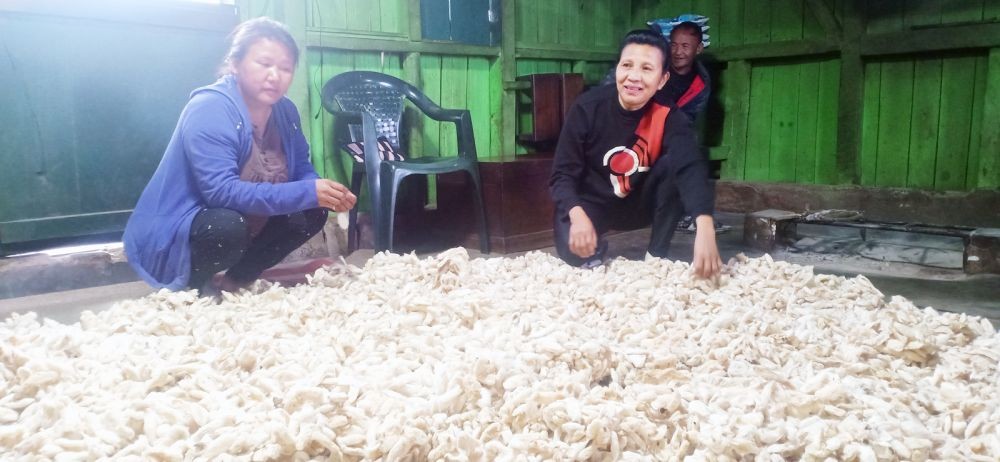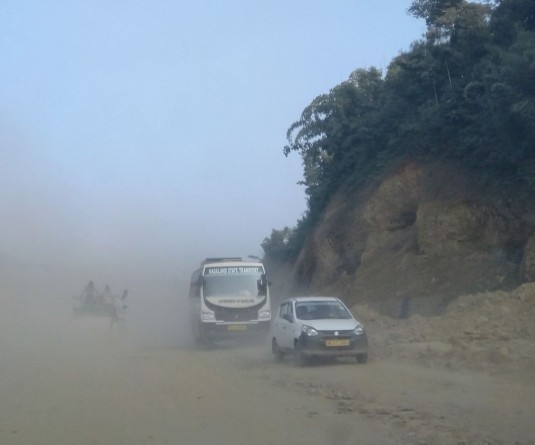Beneficiaries Tsuktinungla and Lanusangla sort out cocoons in Chungtia, Mokokchung. (Morung Photo)

Morung Express News
Chungtia | February 11
Chungtia village in Mokokchung district is emerging as one of the most promising villages in Nagaland with huge potential for Ericulture.
300 families in the village are rearing silkworms through Eri Silk Development Project for Women Empowerment under the North Eastern Region Textile Promotion Scheme (NERTPS), Ministry of Textiles.
While the scheme targets 300 women beneficiaries, there are also several families privately rearing silkworm here. The project is for a period of three years (2018-19 to 2020-2021) and is provided for women beneficiaries.
Since the project was implemented in Chungtia during 2019-20, village authorities have written to the Ministry of Textiles to extend the project till 2021-2022. They have also written to the ministry requesting proper and thorough electrification at the project site.
The Central Silk Board is the implementing agency while Chungtia Village Council is the executing agency and Ministry of Textiles is the funding agency.
The project’s objective is to empower and provide sustainable livelihood to beneficiaries, create awareness especially among women about sericulture activities to generate through Eri spinning and weaving, and to produce 37.80 MT of Eri cut cocoons and 28.35 MT spun yarn during the project period.
Unlike other central schemes which are implemented through the State Government, the NERTPS is implemented directly by the central ministry and all transactions are made through bank accounts.
Speaking to The Morung Express, Nodal Officer cum Consultant for the Project, Imotemjen informed that the project’s total cost is Rs 1773.70 lakh on 90%-10% centre-beneficiary sharing basis. The 10% beneficiaries’ contribution (Rs 63.16 lakh) would be realized mainly through self labour, local materials, land etc. For this particular project, the beneficiaries are executing the project on a community land owned by Chungtia village free of cost.
The centre has released more than Rs 8 Cr as the first installment and another Rs 10 Cr is expected to be released in two installments. Clearing of jungles, plantation, construction of rearing house and all other necessary logistics and developmental activities have been carried out. Rs 1 lakh each on 90%-10% sharing basis has been paid to the first batch of 150 beneficiaries for construction of rearing house while the second batch of 150 beneficiaries would be paid upon receiving the amount from the ministry. Imotemjen said that standard cocoon opener would soon be provided to the beneficiaries.
In addition to the total cost of the project, the Centre has released Rs 19 lakh for construction of approach road to the project site, which is completed.
The Nodal Officer also informed that 70% of pre-cocoon activity works have been completed. He added that 500 persons are supposed to be employed initially under the project. With the target of appointing 300 beneficiaries, 40 adopted seed rearers and 10 private graneurs have been employed, 50 weavers and 100 spinners are yet to be appointed. All 300 women beneficiaries cover an area of 1 acre each.
The Nodal Officer said that the larger area of land at the site is used for plantation of Castor and Kesseru plants to feed the silkworms besides construction of rearing house and other amenities like office. He said the main purpose of the project is to collect empty cocoons for silk production.
Double benefit
Even before government agencies started buying back empty cocoons from farmers and with only 70% of pre-cocoon activity works completed, the beneficiaries have started reaping benefits through sale of silkworms.
Imotemjen cited an instance of a beneficiary earning Rs 50, 000 by selling the worms even before harvesting the cocoons. “Unlike other states where silkworm rearing is purely done for collecting the empty cocoons; in our state and few NE states, farmers get double benefit by selling both the worms and the cocoons since we eat the worm and pupae too,” he pointed out.
Income generation
One beneficiary, Lanusangla (56) said she has earned more than Rs 60,000 through sale of silkworms and also gathered more than 7 kgs of empty cocoons to be sold to the agencies. She sells 80-90 pieces of silkworms for Rs 100.
“With the amount of money earned, I managed to pay school admission fee and other fees for my children,” she disclosed. Last year, she reared more than 30,000 silkworms from her home with the seeds supplied by the agency.
Additionally, she procured local seeds on her own. Imotemjen said that the seeds are procured from Tamil Nadu. On an average, a single cocoon can produce a thread of up to 2 km.
According to Lanusangla, the agency supplied silkworm breed is greenish in colour while the local ones are yellowish. “Taste wise, yellowish breed is better,” said Lanusangla who rears the highest number of silkworms in the village. She was also among 10 beneficiaries from the village selected to undergo 6-day training on seed rearing at Jorhat in January. Lanusangla plans to shift to the project site, 15 kms away from the village, once proper electrification is completed.
Difficulty in collecting feeds
At present most of the beneficiaries are rearing silkworms from their homes since electrification is yet to be completed at the project site. However, several beneficiaries have already made their base there.
Collecting leaves from the project site to feed silkworms is a strenuous activity for the women. In most cases, the husband or children travel 15 km everyday to collect the leaves from the site.
“Sometimes, my husband goes twice or thrice to collect the leaves on a two wheeler since the worms continuously consume the leaves,” said Toshinungla (50). From her earnings, she has bought a water boiler and other kitchen items.
She has also collected around 3 kgs of empty cocoons. The government has provided her seeds, rearing baskets, grass cutters and CGI sheets besides financial assistance.
Imkongnungla (43) who bought crockery out of her profit attests that there is no loss in taking up sericulture. She is now saving up to buy carpet for her house.
Lanusangla meanwhile felt that the beneficiaries could rear large number of silkworms if more baskets are provided.
They have only four baskets each. Another beneficiary felt it pertinent for the government to provide training on silkworm rearing during winter since most of the worms perish and growth is stunted during the cold season. The prime rearing season is from March to November.
As per the Detailed Project Report, the beneficiaries should rear worms at the project site but since even the pre-cocoon work is yet to be fully completed and most importantly the Kesseru plants are yet to mature, they are rearing from their homes.
“But we will follow the DPR once all facilities are completed at the project site,” Imotemjen maintained. He informed that a Centre of Excellence would be established in the village and a Multipurpose Facility Centre would also be constructed.
The scheme provides for the beneficiary to grow plants as well as rear the worms and the two activities are combined. However, if sericulture activity is taken up on large scale even by those not covered under the scheme, it is possible that plant cultivation and silkworm rearing might be carried out as two separate activities.






